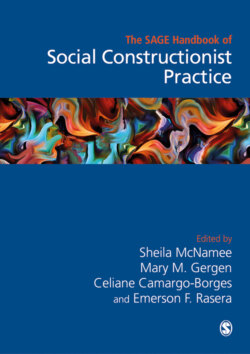Читать книгу The Sage Handbook of Social Constructionist Practice - Группа авторов - Страница 69
На сайте Литреса книга снята с продажи.
An Epistemological Interlude: Reflexivity and Dissonance
ОглавлениеThe case recounted is one example of how I respond to the question of what can I do in my sphere of influence, in my day-to-day personal and professional life. The self involved with action research is a transformative self and this self – and activities with others – are the experiments that help us learn how to enact needed transformations. In the space of the conference we recognized together that part of what inhibits our efforts as scholars is the unquestioned norms of an academia that has yet to truly reckon with the limits to objectivity, much less the need to support active engagement with (rather than distancing description of) our fraying social and ecological ecosystems.
When individuals – and more powerfully as a group – find the opportunity to look under the surface of what inhibits our well-being (a key step in transformation is asking how structures prevent well-being), we may feel our sense of dissonance increase and sense of agency decrease. How to proceed? At first blush the brain, especially when unpracticed in reflective skills, can leap to black and white choices: either I must make a difference or fall back to sleepwalking. Taking things personally and feeling (unconsciously) overwhelmed is, however, paralyzing. What might a middle path, a kind of muddling forward, look like? It helps to recall that this ‘I’ is not alone, but is inside a system co-created with others, because of, and for, others. The question may morph to ‘how can I take responsibility without feeling burdened?’.
By definition, there is no objectivity for a self who investigates their own experience. Bias is always a danger, hence the need for reflexivity and consensus seeking. Reflexivity in inquiry is a central practice of the self-development necessary in action research for transformations. By investigating more of what I am subject to, through making it an object of investigation, the perspective of ‘I’ transforms. To use an analogy, learning improves the capacity to see, much like updating the software that runs the microscopes in a biology lab. This ‘subject object’ investigation provides the basic dialectical mechanism behind adult constructionist development. With it comes the capacity to grow ourselves in complexity to meet what we experience. Such reflexivity is therefore key in our practice as action-oriented researchers for transformation. In the process, we hardly need to be reminded that the dominant, and in many cases powerfully useful, discourse on objectivity, domiant since Descartes, is but a few hundred years old. Moreover, it is waning.
When knowing starts with experience here and now, as when we engage with reflexive practice, the separation between self and other cannot be found. After all the oxygen I breathe or the thoughts I think are not controlled by me. There is – in experience – only one boundless field, that includes me and my personal agency. Contemporary Buddhist philosophy, exemplified in part by the Kyoto school that has arisen around the work of Kitaro Nishida (1979), is grounded on Buddhist experiential concepts – of say a boundless field in which all happens – that are radically systemic. Nishida claims that the self is emergent (there is no separate, fixed self), coming to being and passing away in response to action, interaction with others and universal context. He articulates a relational self (also referred to as no-self). Experiential reality is naturally already interconnected. When persons tap into this collective field, collaborative knowing can open up new avenues for inquiry and reflective conceptual knowledge that emerge from the relationships involved.
